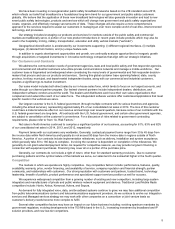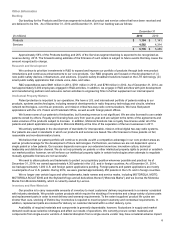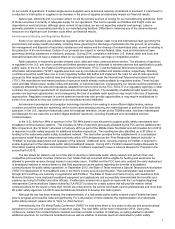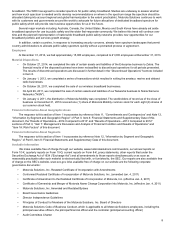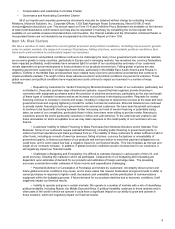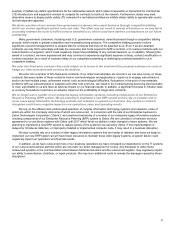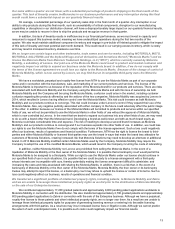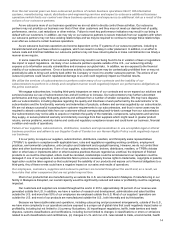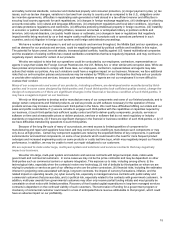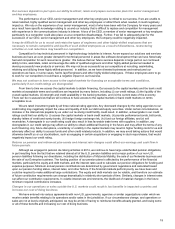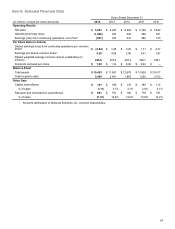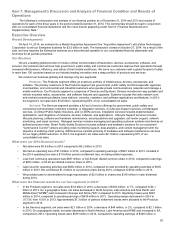Motorola 2014 Annual Report Download - page 17
Download and view the complete annual report
Please find page 17 of the 2014 Motorola annual report below. You can navigate through the pages in the report by either clicking on the pages listed below, or by using the keyword search tool below to find specific information within the annual report.15
and safety, technical standards, consumer and intellectual property and consumer protection, (iv) longer payment cycles, (v) tax
issues, such as tax law changes, variations in tax laws from country to country and as compared to the U.S., obligations under
tax incentive agreements, difficulties in repatriating cash generated or held abroad in a tax-efficient manner and difficulties in
securing local country approvals for cash repatriations, (vi) changes in foreign exchange regulations, (vii) challenges in collecting
accounts receivable, (viii) cultural and language differences, (ix) employment regulations and local labor conditions, (x) privacy
and data protections regulations and restrictions, (xi) difficulties protecting intellectual property in foreign countries, (xii) instability
in economic or political conditions, including inflation, recession and actual or anticipated military or political conflicts and
terrorism, (xiii) natural disasters, (xiv) public health issues or outbreaks, (xv) changes in laws or regulations that negatively
impact benefits being received by us or that require costly modifications in products sold or operations performed in such
countries, and (xvi) litigation in foreign court systems and foreign administrative proceedings.
We have a number of employees in, and sell our products and services throughout, the Middle East and our operations, as
well as demand for our products and services, could be negatively impacted by political conflicts and hostilities in this region.
The potential for future unrest, terrorist attacks, increased global conflicts, hostility against U.S.-based multinational companies
and the escalation of existing conflicts has created worldwide uncertainties that have negatively impacted, and may continue to
negatively impact, demand for certain of our products.
We also are subject to risks that our operations could be conducted by our employees, contractors, representatives or
agents in ways that violate the Foreign Corrupt Practices Act, the U.K. Bribery Act, or other similar anti-corruption laws. While we
have policies and procedures to comply with these laws, our employees, contractors, representatives and agents may take
actions that violate our policies. Any such violations could have a negative impact on our business. Moreover, we face additional
risks that our anti-corruption policies and procedures may be violated by TPSRs or other third-parties that help sell our products
or provide other solutions and services, because such representatives or agents are not our employees it is more difficult to
oversee their conduct.
Many of our components and some of our products, including software, are developed and/or manufactured by third-
parties and in some cases designed by third-parties and if such third-parties lack sufficient quality control, change the
design of components or if there are significant changes in the financial or business condition of such third-parties, it
may have a negative impact on our business.
We rely on third-parties to develop and/or manufacture many of our components and some of our finished products, and to
design certain components and finished products, as well as provide us with software necessary for the operation of those
products and we may increase our reliance such third-parties in the future. We could have difficulties fulfilling our orders and our
sales and profits could decline if: (i) we are not able to engage such third-parties with the capabilities or capacities required by
our business, (ii) such third-parties lack sufficient quality control and fail to deliver quality components, products, services or
software on time and at reasonable prices or deliver products, services or software that do not meet regulatory or industry
standards or requirements, (iii) if there are significant changes in the financial or business condition of such third-parties, or (iv) if
we have difficulties transitioning operations to such third-parties.
Because of the long life-cycle of many of our products, we need access to limited quantities of components for
manufacturing and repair and suppliers have been and may continue to be unwilling to manufacture such components or may
only do so at high prices. Certain key component suppliers are reducing the expected lifetime of key components, in particular
semiconductor and electrical components, on some of our products which could result in the need for more frequent product
redesigns and increased engineering costs on some products or costly last time buys, which may negatively impact our financial
performance. In addition, we may be unable to meet our repair obligations to our customers.
We are exposed to risks under large, multi-year system and solutions and services contracts that may negatively
impact our business.
We enter into large, multi-year system and solutions and services contracts with large municipal, state, nation-wide
government and commercial customers. In some cases we may not be the prime contractor and may be dependent on other
third-parties such as commercial carriers or systems integrators. This exposes us to risks, including among others: (i) the
technological risks, especially when the contracts involve new technology, (ii) risk of defaults by third-parties on whom we are
relying for products or service as part of our offering or who are the prime contractors, (iii) financial risks, including the estimates
inherent in projecting costs associated with large, long-term contracts, the impact of currency fluctuations, inflation, and the
related impact on operating results, (iv) cyber security risk, especially in managed services contracts with public safety and
commercial customers that process data, and (v) political risk, especially related to the contracts with government customers. In
addition, multi-year awards from governmental customers may often only receive partial funding initially and may typically be
cancelable on short notice with limited penalties. Recovery of front loaded capital expenditures in long-term managed services
contracts is dependent on the continued viability of such customers. The termination of funding for a government program or
insolvency of commercial customer could result in a loss of anticipated future revenue attributable to that program, which could
have an adverse impact on our profitability.


